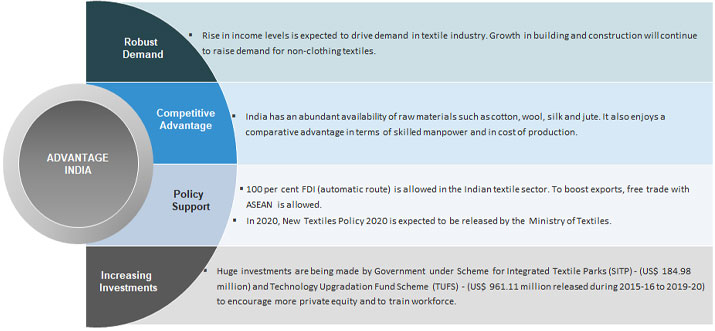Indian Economy
Textile Sector and Atmanirbharta
- 20 Jun 2020
- 8 min read
This article is based on the Textile sector needs a vision and mission which was published in The Hindu BusinessLine on 19/06/2020. It talks about significance, challenges and the way forward for the textile sector.
Amid economic crisis due to covid-19 pandemic, the government has embraced ‘self-reliance’ as a development strategy to reboot the Indian economy. It is about tapping India’s inherent strengths to emerge stronger as a nation, economically and in all other aspects.
However, the government should not lose sight of sectors which are already self-reliant and can, with a little help, play a larger role in the global market. The textile sector is one such sector.
Even though Indian textile industry is one of the oldest industries of the Indian economy, it is also a fact that the Indian textiles industry finds it difficult to compete with much smaller global players such as Bangladesh and Vietnam.
It can be corroborated that there are some deep-rooted problems with the sector, and these need to be addressed to see any long-term sustainable revival in the sector. In this context, there is an urgent need to identify some of the challenges and the way forward for the textile sector.
Significance of Textile Sector
- The sector accounts for 7% of India’s manufacturing output, 2% of GDP, 12% of exports and employs directly and indirectly about 10 crore people.
- Owing to the abundant supply of raw material and labour, India is-
- The largest producer of cotton, accounting for 25% of the global output.
- The world’s second-largest producer of textiles and garments after China.
- The second-largest producer of man-made fibres — polyester and viscose.
- Most importantly, in India a strong domestic market is available.
Challenges in Textile Sector
- Highly fragmented: The Indian textile industry is highly fragmented and is being dominated by the unorganized sector and small and medium industries.
- Outdated technology: The Indian textile industry has its limitations of access to the latest technology (especially in small-scale industries) and failures to meet global standards in the highly competitive market.
- Inflexible labour laws: India's system of labour regulations is rather complex. There are over 200 labour laws, including a quarter of Central Acts.
- Several labour laws such as the Industrial Disputes Act, 1947 put limitations on firm size and not allow manufacturing firms to grow.
- Tax structure issues: The tax structure GST (Goods and Service Tax) makes the garments expensive and uncompetitive in domestic as well as international markets. Another threat is rising labour wages and workers’ salaries.
- Stagnant exports: The export from the sector has been stagnating and remained at the $40-billion level for the last six years.
- Lack of scale: The apparel units in India have an average size of 100 machines which is very less in comparison with Bangladesh, which has on an average of at least 500 machines per factory.
- Lack of foreign investment: Due to challenges given above the foreign investors are not very enthusiastic about investing in the textile sector which is also one of the areas of concern.
- Though the sector has witnessed a spurt in investment during the last five years, yet the industry attracted Foreign Direct Investment (FDI) of only US$ 3.41 billion from April 2000 to December 2019.
Way Forward
- Toward an organised sector: India can make the sector organised by setting up mega apparel parks and common infrastructure for the textile industry.
- This will increase the scale of production and help Indian players to produce faster and at a lower cost with maximum efficiency in operation.
- Facilitate modernisation of the industry: Focus should be on the modernisation of the obsolete machinery and technology. This can help increase the production and productivity of the textile industry and thereby increase the export also.
- Programmes such as the National Technical Textiles Mission, Amended Technology Up-gradation Fund Scheme (ATUFS) and Integrated Wool Development Programme (IWDP) should be implemented in the most effective manner.
Amended Technology Upgradation Fund Scheme (ATUFS)
- The Technology Upgradation Fund Scheme was introduced by the Government in 1999 to facilitate new and appropriate technology for making the textile industry globally competitive and to reduce the capital cost for the textile industry.
- In 2015, the government approved "Amended Technology Upgradation Fund Scheme (ATUFS)" for technology upgradation of the textiles industry.
- Attracting Foreign Investments (FDI): The Indian government has come up with a number of export promotion policies for the textiles sector. For example, India has allowed 100% FDI in the Indian textiles sector under the automatic route.
- To increase the ease of doing business for foreign investors, the single-window clearances and all kinds of resolution mechanisms should be provided.
- Need for rational labour laws: Several high-level expert panels have recommended to remove limitations on firm size and allow flexibility in hiring and firing.
- Thus, there is a need for early rationalisation of such labour laws.
- Increasing export: India also needs to sign trade agreements with developed countries to enhance export opportunities.
- Such Free Trade Agreements (FTAs) can help gain duty-free access to large textile markets such as the EU, Australia and the UK.
Conclusion
India needs a comprehensive blueprint for the textile sector. Once that is drawn up, the country needs to move into mission mode to achieve it. In this context, the new Textiles Policy 2020 being formulated by the Centre should aim at developing a competitive textile sector which is modern, sustainable and inclusive.
|
Drishti Mains Question “A competitive textile sector is modern, sustainable and inclusive.” Discuss the challenges and measures that should be taken to develop such a competitive textile sector in India. |
This editorial is based on “At the high table: On India’s U.N. Security Council win” which was published in The Hindu on June 19th, 2020. Now watch this on our Youtube channel.





